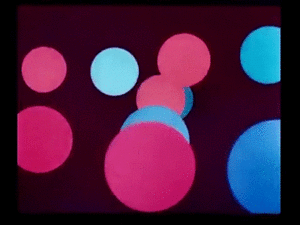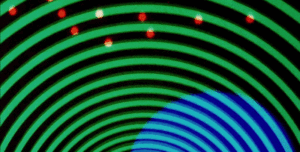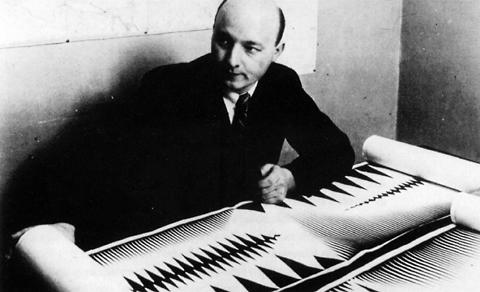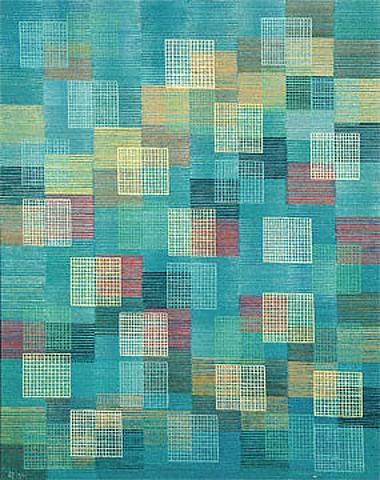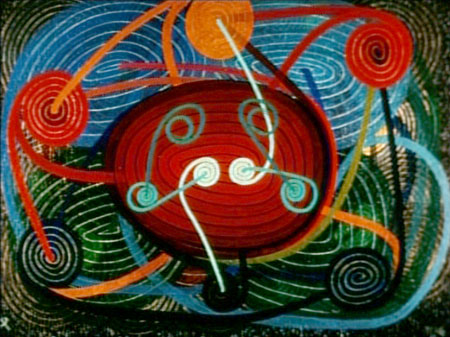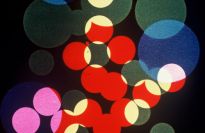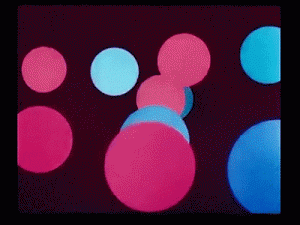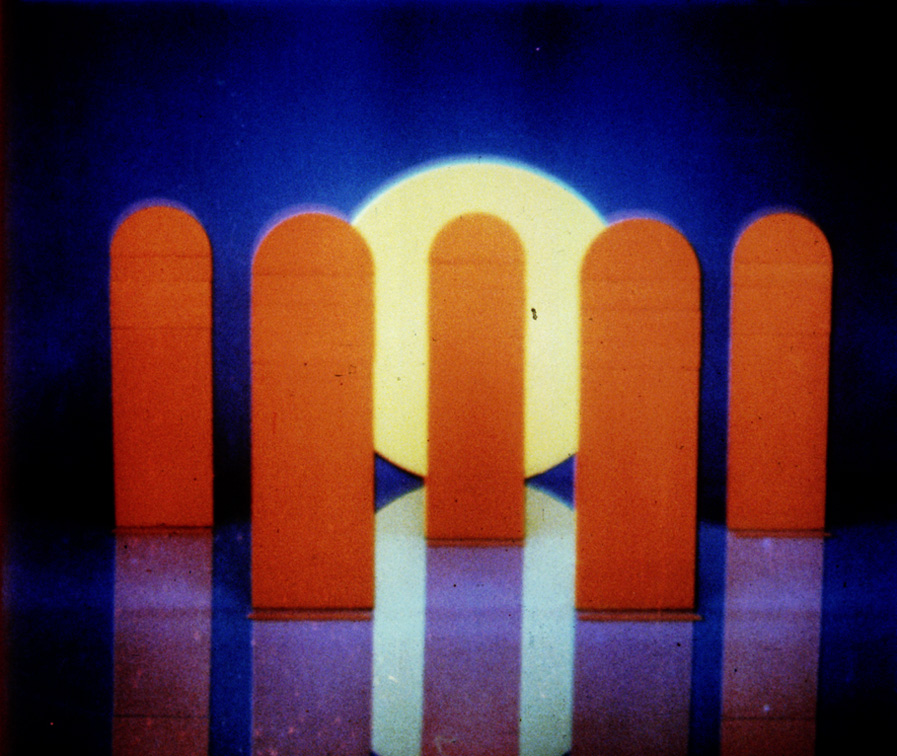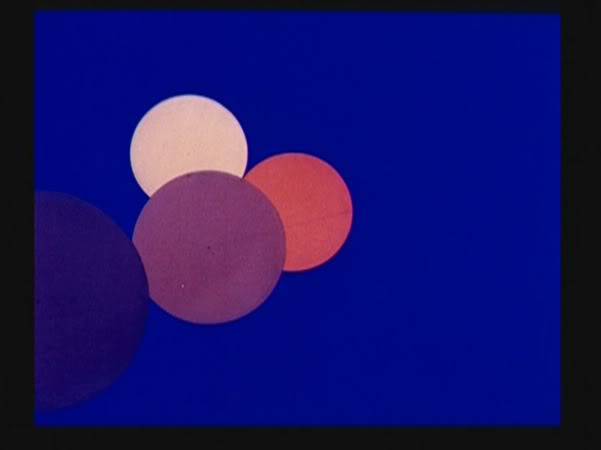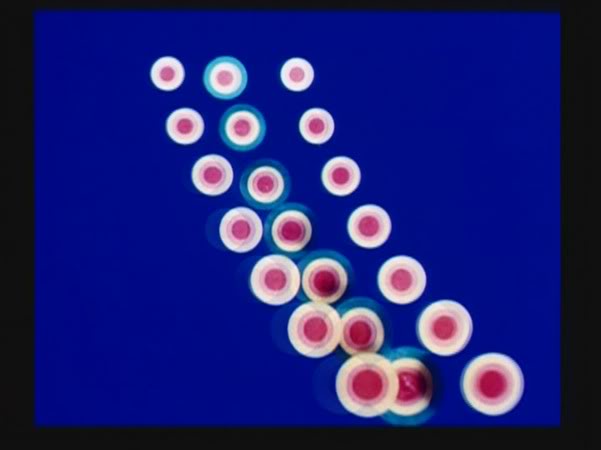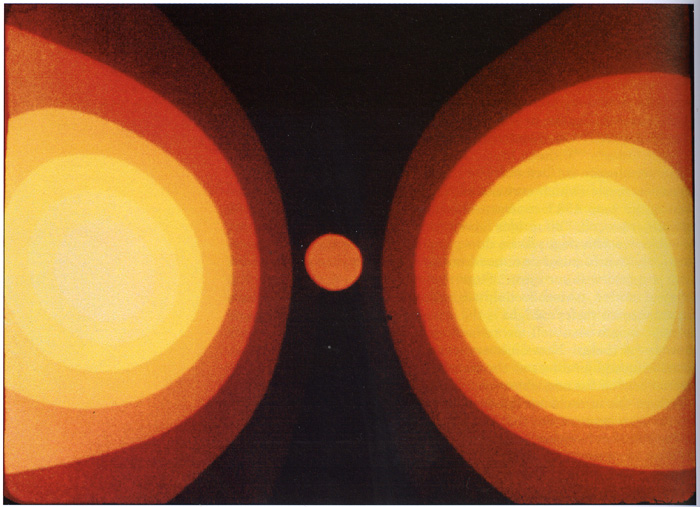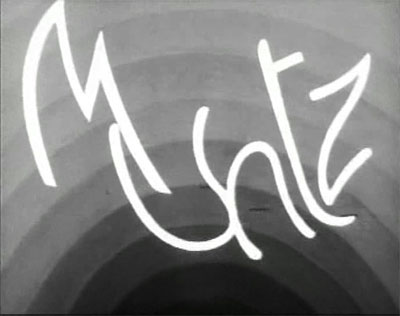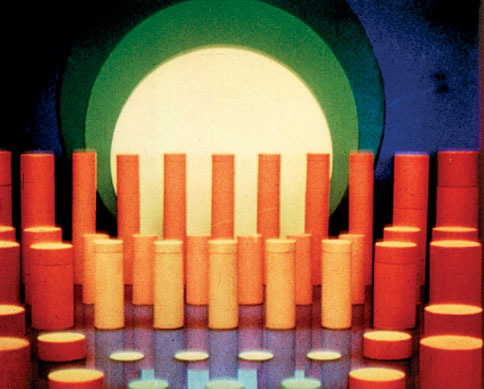An email from Cindy Keefer updating and correcting much of what follows:
—
www.centerforvisualmusic.org
***
From the Chicago Reader, April 20, 2001; minor adjustments made on January 10, 2010. And for some major corrections and more up-to-the-minute additions, see the letter from Cindy Keefer that I’ve added to the end of this piece. — J.R.
Music for the Eyes: Films by Oskar Fischinger
By Jonathan Rosenbaum
While I was living in Paris in my late 20s I used to dream of making a film — if someone were to hand me an outsize check and give me carte blanche, which of course I knew would never happen. I had a project in mind. I wanted to film all of my best friends dancing as uninhibitedly and joyfully as possible alongside the Seine, and then I wanted to devote the next several years of my life to synchronizing their movements to an up-tempo number by Ahmad Jamal’s piano trio. Jamal was unfashionable among jazz critics — even though Miles Davis delighted in his music — and that only made the project more seductive.
The notion of combining music I loved and people I loved was the key to this idle fantasy. Furthermore, Jamal’s music made me want to dance and conjured up moving images, and I wanted to synthesize these sensations. Last week I saw him play with his current trio, and though he was seated, his orchestrated body movements and occasional grunts of pleasure while making characteristically melodramatic shifts in dynamics or telegraphing instructions to his bassist and drummer added up to a kind of ecstatic dance that reminded me of my old pipe dream.
A desire to find visual correspondences with music is no doubt quite common, yet to devote an entire career to fulfilling and justifying such a desire might seem a narrow aspiration. It’s certainly possible for art — and not only Hollywood movies — to be extremely beautiful and pleasurable yet not especially interesting to think about. All of the abstract animation of Oskar Fischinger (1900-1967) I’ve seen brushes against that possibility, so my love for his work has always been qualified by doubt — the kind of doubt that may help explain why Fischinger’s position within the avant-garde has never been firmly settled.
He started doing silent work in the 1920s that was a purely visual music, before moving logically toward music and image duets in the 1930s; he then, just as logically, turned again toward silent visual music. His oeuvre — which is contained in almost 200 cans of nitrate and safety film and includes various experiments and fragments as well as advertising films — can be seen as single-minded and varied, rich and monotonous, programmatic and technically innovative.
Fischinger worked for luminaries such as Fritz Lang in Germany and — after 1936, when he moved to the U.S., where he remained until his death — Walt Disney and Orson Welles in Hollywood. He also left behind 700 oil and pastel paintings — most of them unrelated to his animation — though he regarded these canvases as secondary to his filmmaking.
The question of where Fischinger belongs in the history of art as well as cinema is bound to be explored — if not settled — in a daylong tribute to his work this Saturday at the University of Chicago. The program is grandly titled “Kinetica 2: A Centennial Tribute to Oskar Fischinger,” and it’s been grandly put together by the iotaCenter in association with the Film Archive of the Academy of Motion Picture Arts and Sciences and the Fischinger Archive — a mouth-filling combo suggesting, like Fischinger himself, a rare fusion of pop culture and high art, with unfashionable crossovers running in both directions.
The tribute starts with a comprehensive retrospective, “Masterworks and Rarities,” of Fischinger’s work from 1927 to around 1960, in restored 35-millimeter prints, at Doc Films at 12:30 PM; that will be followed by a panel discussion featuring his daughter and four academics. A separate program, “Legacy,” devoted to the work of animators who’ve followed in Fischinger’s footsteps, will be offered at 7 PM in Cobb Hall’s Film Studies Center. (The Doc Films program costs $5; admission to “Legacy” is free.) Whether they settle any big issues or not, these events are bound to offer the best chance to assess Fischinger’s work that Chicagoans are ever likely to get.
The son of shopkeepers and brewers in Gelnhausen, Germany, Fischinger worked in his teens as an apprentice organ builder, as an architect’s draftsman, and, after moving to Frankfurt, as a tool designer. He reportedly discovered his vocation through the newspaper articles of an art critic named Bernhard Diebold, who welcomed a new approach to cinema that involved abstraction and blended painting, sculpture, dance, and music in a bold new synthesis. After making Diebold’s acquaintance, Fischinger gave a lecture for a literary club around 1921 that used graphic charts to display the aesthetic “dynamics” of two plays, Shakespeare’s Twelfth Night and Fritz von Unruh’s expressionistic antiwar drama Ein Geschlecht. According to Fischinger biographer William Moritz, who wrote a book-length essay on him for Film Culture in 1974, “These scroll-like charts do not try to show just the literal movements and gestures of the actors, but rather by abstract designs try to convey the changing moods, the flow of emotion, the intensity, style, and flourish of the ideas and the experiences created by the process of the action.” The abstract films that grew out of these charts were contemporaneous with those of Walter Ruttmann, Viking Eggeling, and Hans Richter. The first and perhaps most gifted of these figures, Ruttmann — who worked for Fritz Lang many years before Fischinger, contributing an animated dream sequence to Die Niebelungen — premiered the first abstract film in 1921, showing it with a live synchronous musical score.
Still from Komposition in Blau (1935), (c) Fischinger Trust
Fischinger’s remaining 15 years in Germany yielded many of his best films, including R-1, Ein Formspiel (1927), a seven-minute triptych (the first and third panels mirroring each other) that’s accompanied by a kind of industrial music; advertising films from the 30s for cigarettes (which dance in chorus lines) and an ad agency named Tolirag (the 1933 Kreise, or Circles, works from the slogan “Tolirag reaches all circles,” creating an arresting blue, red, and green op art of approaching, receding, drifting, and gamboling circles, all to the strains of Wagner and Grieg); the one-and-a-half-minute, black-and-white Liebesspiel (1931), “a song without music”; and the magisterial four-minute Composition in Blue (1935). There are also many numbered “studies” made between 1929 and 1934 and nonanimated “scrapbooks” of walking trips, including the three-minute, single-frame compilation Walking From Munich to Berlin (1927) and the 13-minute Swiss Trip (1934), which combines single frames and longer takes, all synchronized to Bach’s third Brandenburg Concerto. The same period in Germany yielded what was probably Fischinger’s most satisfying early work for a film studio — his special-effects work on Lang’s Woman in the Moon (1929), which included model rockets, simulated spaceflights, skywriting, flotation in zero gravity, and hallucinations involving gold.
By contrast, most of his early forays into Hollywood studio work were disasters, exacerbated by his inability to speak English and dependence on studio interpreters. After many protracted misunderstandings, nothing of his work wound up in a Paramount B musical called Big Broadcast of 1937. A couple of years later he had some hope of becoming a “supervisor of visuals” on Walt Disney’s Fantasia, but his ambitious ideas for abstract accompaniments to Bach’s Toccata and Fugue in D minor were so vulgarized he removed his name from the picture’s credits and eliminated the film’s title from his resumé. (Not that his ideas weren’t populist or playful: one that Disney rejected was to have Leopold Stokowski’s hands fly away and turn into the piece’s opening bars of musical notes before metamorphosing into abstract colors and shapes.) In between came what was perhaps Fischinger’s most successful studio contract, with MGM — acquired through the help of his friend, director William Dieterle — which allowed him to take an animation technique using paper cutouts suspended on sticks and wires that he’d introduced in Composition in Blue and develop it in An Optical Poem (1937), scored to Liszt’s second Hungarian Rhapsody. This film survives today only because Fischinger preserved his own copy; MGM, after showing it across the country, allowed the original negative to decompose.
Fischinger’s yearlong stint (1941-’42) with Orson Welles on the never completed It’s All True — an episodic potpourri that went through many different incarnations — never yielded a contribution to the movie. But his work with Welles nurtured and may have virtually subsidized his extraordinary silent, four-minute Radio Dynamics (1942, see below), which Moritz regards, probably justly, as Fischinger’s masterpiece. It also gave him plenty of time to develop his talent for cel animation. Welles — who kept Fischinger as his personal employee at the Mercury unit despite the wartime injunction against hiring “enemy aliens” — first put him to work planning abstract animation to accompany jazz in a biography of Louis Armstrong to be scored by Duke Ellington; when the “story of jazz” mutated into the “story of samba,” after Nelson Rockefeller persuaded Welles to make a film in Brazil, Fischinger apparently adapted his designs to live carnival music recorded by Welles in Rio. Fischinger also prepared a credits sequence for Jane Eyre, produced by Welles, and designed a dream sequence for Lang’s Secret Beyond the Door, neither of which was used. A more successful commercial venture was his great one-minute, black-and-white 1952 singing commercial for Muntz TV sets — an endlessly inventive and blossoming explosion of curves, stripes, tonalities, and letters.
I suspect that one thing keeping Fischinger unfashionable in some avant-garde circles is the lack of meaningful correlation between his best work and his most independent work, or between his worst work and his most commercial assignments (leaving aside the work he understandably disowned, such as the Bach segment in Fantasia). There’s also no meaningful correlation that I can find between the value of individual works and how abstract or representational they are. The perpetually mutating and slithering silhouetted human figures and furniture of Spiritual Constructions — a black-and-white film from 1927 that Moritz describes as a “meditation on violence” encapsulating everything Fischinger hated about the drunkenness and aggressive behavior he found in German beer halls — is no less aesthetically pleasing than the pristine ballet of geometrical figures in the color Composition in Blue. And whatever the jazz- or samba-related sources of Radio Dynamics, what finally emerged, beginning with the pointed title, “No music please — an experiment in color-rhythm,” is a luscious and pulsating visual music that’s simply too rich to be encapsulated as a Klee or a Kandinsky in a constant state of becoming, even if it fleetingly suggests such a conceit. Instead it’s a visual music so generous, plentiful, joyful, and alive it finally makes musical accompaniment superfluous — and makes one want to dance as much as an unfashionable up-tempo Ahmad Jamal solo does.
Dear Jonathan,
Many thanks for the focus today on Oskar Fischinger and his work, and your continual support. I’m writing to give a few later corrections and some updates, and mostly, beg for some type of link or reference…so those interested can find accurate information online. I believe you have our Fischinger DVD; have you seen our Fischinger Research pages?
Link for Fischinger Ten Films DVD – www.centerforvisualmusic.org/DVD.htm
Is it at all possible to include one of these above links so people can learn more about Fischinger? Our archive has Fischinger’s original papers (as well as William Moritz’s), and we are adding more of these resources online over the next few years.
And the Fischinger Trust would be very, very, very happy to see a (c) Fischinger Trust credit for the images (all except An Optical Poem), if you are inclined, though it’s not a big deal. And btw we would have been pleased to provide higher res, unfuzzy images…
Just a few corrections/notes –
–Fischinger left over 800 paintings plus numerous drawings; there are a good amount of both which are extremely related to his films, and many are actual studies for films.
–About R-1, Ein Formspiel (1927), it’s described here as “a seven-minute triptych (the first and third panels mirroring each other)” but actually that ‘mirroring’ is only true of Moritz’s 1993 recreation of such, and that date is quite approximate. Here is a recently published article of mine in Leonardo, on Fischinger’s early multiiple-projector performances such as R-1:
Keefer, Cindy. ‘Raumlichtmusik’ – Early 20th Century Abstract Cinema Immersive Environments. Leonardo Electronic Almanac, Creative Data Special Issue. Leonardo: The International Society for the Arts, Sciences, and Technology, and MIT Press. October 2009.
PDF: http://www.leonardo.info/LEA/CreativeData/CD_Keefer.pdf
–Re this statement re An Optical Poem, “This film survives today only because Fischinger preserved his own copy; MGM, after showing it across the country, allowed the original negative to decompose.” I have never found evidence that this is true, though MGM did destroy many prints. This may be a Moritz myth from Film Culture? (Many of those earlier FC myths and errors were corrected by him in his 2004 Optical Poetry). The current owners of the MGM materials today have a beautiful IB Technicolor print among other elements, and in fact provided a print (though not Technicolor) for that very same Fischinger Retrospective tour in 2001. The current prints available today are from the MGM elements; as this film is the only one not distributed or managed by The Fischinger Trust or CVM. However we do have the original paper cutout circles, and The Fischinger Archive has the backgrounds, as well as a few of Fischinger’s prints, and thus we can absolutely verify that the colors on the Unseen Cinema DVD are completely wrong, the pinks and blues seen there are incorrect. That film has golds, yellows, browns.
–The show you referenced in that 2001 article is now called Optical Poetry: Oskar Fischinger Retrospective. Since 2003 it’s been distributed by Center for Visual Music, in association with Fischinger Archive, to venues worldwide including Lincoln Center. (All relations between iotacenter and the Fischinger Archive, films and estate were completed and totally severed in 2003.)
About Fischinger and current access, just a little news:
–Since October we’ve had Fischinger films in our regular series at The Guggenheim, NY accompanying the Kandinsky exhibition; and three are screened this Tuesday at the Guggenheim’s symposium on Kandinsky. This series repeats twice in February; then our new series (all in film!) with more Fischinger screens March-May.
–Animation World Network Headline News about some of our current preservation of Fischinger films:
http://www.awn.com/news/business/center-visual-music-preserve-fischinger-experiments
–Recently we’ve exhibited digital versions of Fischinger films in museum exhibitions in Berlin, Lisbon, Linz, Austria; Miami and others, and upcoming, a Basel exhibition. We’ve recently screened his films (on film) at symposiums at Tate Modern, London and San Diego Museum of Art and now The Guggenheim. Other of his films are in our other traveling programs such as “Essential Visual Music” screening recently at UCLA Film & TV Archive/Hammer Museum; Pacific Film Archive and many other venues in the US, Europe and Australia. www.centerforvisualmusic.org/Events.htm
And of course you must know about the 2005 Visual Music exhibition at Hirshhorn and MOCA, where Fischinger was the most-featured filmmaker. More Fischinger coming soon in some major museums…
That’s a few of the recent activities, enough for now…many more coming up including some installations of the early multiple projector films….
And many thanks for your continual support of Fischinger.
best regards,
Cindy Keefer for
Center for Visual Music and The Fischinger Archive
Los Angeles, CA
www.centerforvisualmusic.org

